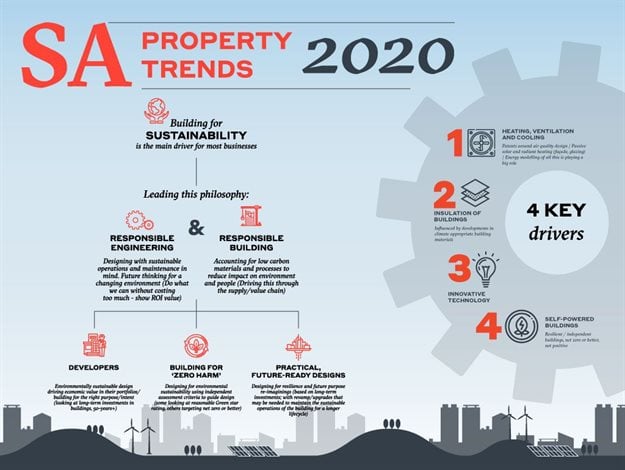#BizTrends2020: Building for sustainability continues to promote valuable returns

Despite the current economic climate - linked to fluctuations in global markets and further exacerbated by policy changes and political uncertainty locally – there are domestic and international investors and developers who continue to forge ahead with projects across South Africa, as they see the great potential and value here. Furthermore, building for sustainability has become the main driver for most investors and developers.
We expect this trend to continue well into the future as government, businesses and citizens, alike and as the primarily targeted tenants of industrial and commercial spaces, grow increasingly socially conscious to the importance of resilience and the need to safeguard and manage critical resources in a more sustainable fashion.
Energy and water security
For instance, each time the country has intermittently experienced load shedding – and particularly since 2008 – this continues to increase social awareness on the importance of secure power, and sparks interest among developers to investigate solar-powered rooftop or onsite solutions that could self-power their buildings in the event of grid power interruptions. Likewise, the water shortages – and water restrictions as a result – that many areas across the country have faced in the last 24 months have created a sense of urgency across the country to look at more efficient water management solutions within buildings. This has also opened up opportunities to capture and use rainwater, or to safely recycle and reuse grey water, to meet their essential operational and living needs.
It’s no surprise then that this rising social consciousness, coupled with continuous and growing pressure being placed on the ‘built’ space to address inadequate energy resources, carbon reduction targets and tightening building energy efficiency standards continue to drive sustainable building trends in South Africa. In fact, building for sustainability and climate change mitigation has become integral in the design and construction of buildings in the country.
Responsible engineering
The philosophy of building for sustainability is being led by responsible engineering (do what we can without costing too much – show return on investment value) and responsible building (driving this through the supply/value chain). In the accompanying infographic we have depicted what underpins these aspirations, as well as four key emerging design elements that are driving such sustainable building interventions forward.
While previously it was thought to be more expensive to make the upfront capital investments to go green, volatility in both the cost and availability of power and water resources, for example, is influencing a mind-set change. Added to this, if we look at the whole lifecycle design of a building; architects, consulting engineers and sustainability consultant teams are constantly coming up with alternative and environmentally suitable building designs to offset the impact of the building on its immediate environment.
Therefore, in the long-term, not only are sustainable building design adoptions financially beneficial due to reduced energy consumption, but the use of renewable and more sustainable energy resources also has the propensity to reduce the carbon emissions associated with these buildings and provide increased resilience to uncertain service delivery.
Benefits of being “green”
These are all significant value adds to the customer/tenant – and what benefits the customer also benefits the developer/owner – as savvier customers are also realising the benefits of being more “green” and offsetting as much of their energy and water consumption as possible given the many benefits of doing so.
The rising social consciousness agenda is having a significant influence on the economic case for developments to be built for sustainability, which can assist in increasing their marketability. What is then key is for investors, developers and their consultants and contractors to aspire to is to incorporate “climate responsiveness” and “designing within constraint” concepts when developing buildings – to ensure that these buildings remain resilient and sustainable in an unpredictable future context.












